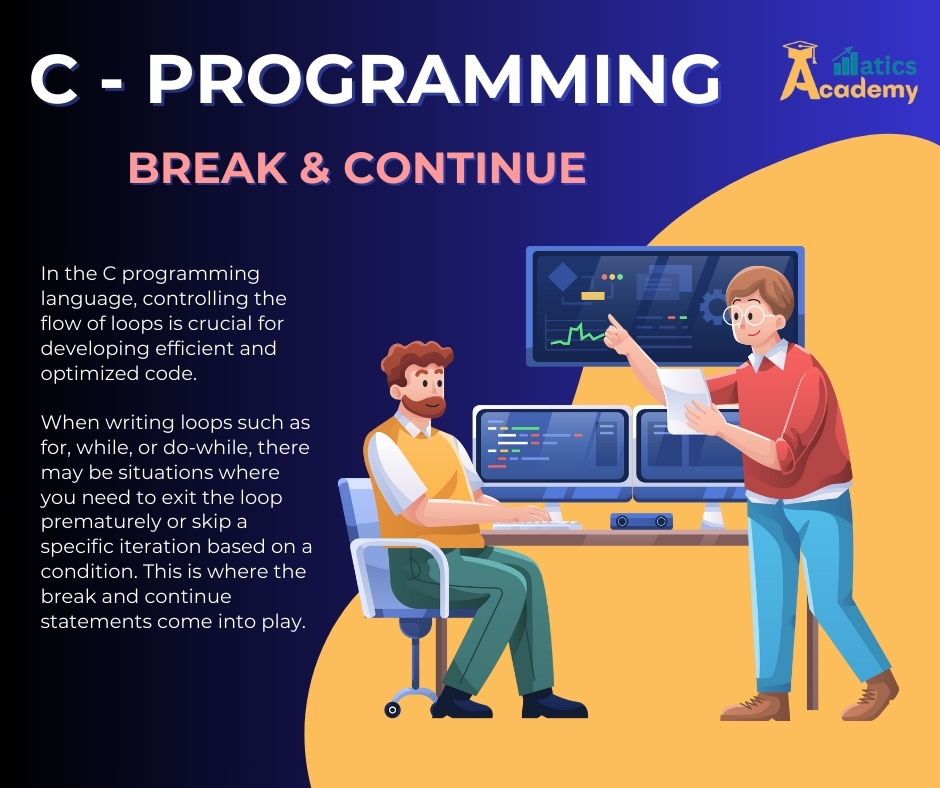Introduction
In the C programming language, controlling the flow of loops is crucial for developing efficient and optimized code. When writing loops such as for, while, or do-while, there may be situations where you need to exit the loop prematurely or skip a specific iteration based on a condition. This is where the break and continue statements come into play.
Understanding how these control statements work allows developers to improve code readability, avoid unnecessary iterations, and handle special cases efficiently within loops and switch statements.
In this tutorial, we will explore:
- The purpose and syntax of the
breakandcontinuestatements - How they work inside loops and switch cases
- Key differences between
breakandcontinue - Common use cases and real-world applications
- Best practices to follow when using them in C programs
- Sample programs and exercises to reinforce learning

What is the break Statement in C?
The break statement is used to terminate the execution of a loop or switch case when a specific condition is met. Once the break statement is executed, the program control immediately jumps to the statement following the loop or switch block.
Syntax
break;
This simple statement can be used in all types of loops (for, while, and do-while) and in switch statements.
How break Works in a Loop
When the loop begins, the program evaluates the loop condition and executes its body. If a break statement is encountered during this process:
- The loop is exited immediately, even if the loop condition still holds true.
- The program control transfers to the next statement that follows the loop.
Example: Using break in a for Loop
#include <stdio.h>
int main() {
int i;
for (i = 1; i <= 10; i++) {
if (i == 5) {
break;
}
printf("%d ", i);
}
return 0;
}
Output
1 2 3 4
In this example, the loop stops running when the value of i reaches 5. As a result, numbers 5 through 10 are never printed.
Using break in a Switch Case
In a switch statement, the break statement prevents the program from executing subsequent cases once a match is found.
Example: break in a switch Statement
#include <stdio.h>
int main() {
int choice = 2;
switch (choice) {
case 1:
printf("You selected option 1\n");
break;
case 2:
printf("You selected option 2\n");
break;
default:
printf("Invalid option\n");
}
return 0;
}
Output
You selected option 2
Without the break statement, the program would continue executing the remaining cases even after finding a match, which is known as fall-through behavior.
What is the continue Statement in C?
The continue statement is used to skip the rest of the code inside the current iteration of a loop and jump to the next iteration.
Unlike break, which terminates the loop entirely, continue skips the current iteration and proceeds with the loop’s next cycle.
Syntax
continue;
How continue Works in a Loop
When the program encounters the continue statement during a loop execution:
- The remaining statements in the loop body for the current iteration are skipped.
- The loop then evaluates the condition for the next iteration.
This statement is most useful when you want to skip over particular elements or conditions while still allowing the loop to continue.
Example: Using continue in a for Loop
#include <stdio.h>
int main() {
int i;
for (i = 1; i <= 5; i++) {
if (i == 3) {
continue;
}
printf("%d ", i);
}
return 0;
}Output
1 2 4 5
The value 3 is skipped because the continue statement causes the loop to bypass the printf function for that iteration.
Key Differences Between break and continue
| Feature | break | continue |
|---|---|---|
| Primary Purpose | Exits the loop or switch statement | Skips the current iteration of a loop |
| Affects | Entire loop or switch case | Only the current iteration of the loop |
| Position of Control | Moves control outside the loop/switch | Moves control to the next loop iteration |
| Common Use Cases | Early exit when condition is met | Skipping invalid or unwanted input/data |
| Loop Termination | Yes | No |
Common Use Cases
Use Cases for break
- Breaking out of infinite loops becomes essential when a specific condition is met; for instance, to avoid unnecessary iterations
- Terminating a search operation early for performance
- exiting a loop as soon as a desired element is found in an array helps improve performance and prevents redundant checks
- Preventing fall-through in switch statements
Use Cases for continue
- Skipping invalid or null entries in a data-processing loop
- In certain scenarios, such as when filtering out specific values like even numbers or negative inputs, the
continuestatement becomes especially useful because it allows the program to skip those values and proceed with the next iteration efficiently. - Ignoring certain conditions in nested loop operations
- Simplifying complex conditional logic in loops
Best Practices
- Use break sparingly in loops
Overusingbreakcan make your loop logic harder to follow and debug Use it when necessary for early exits. - Use continue for filtering
If you need to skip over specific data or input values,continuehelps keep your code clean and readable. - Avoid deep nesting
Excessive use of nested loops combined withbreakandcontinuecan reduce code readability & Try to refactor such logic when possible. - Always add comments
Clarify the reason for usingbreakorcontinue, especially when working in teams or writing large applications. - Ensure conditions are clear
Use meaningful conditions withbreakandcontinueto make the loop behavior predictable and logical.
Real-World Scenario: Using break and continue in a Menu-Driven Program
Consider a program where a user chooses options from a menu. You can use break to exit a loop when the user selects “Exit,” and use continue to skip invalid menu entries.
Practice Exercise
Question:
Write a C program using a for loop that prints numbers from 1 to 10, but skips printing 5 and 7 using the continue statement.
Solution
#include <stdio.h>
int main() {
int i;
for (i = 1; i <= 10; i++) {
if (i == 5 || i == 7) {
continue; // Skip 5 and 7
}
printf("%d ", i);
}
return 0;
}Expected Output
1 2 3 4 6 8 9 10
Conclusion
Both break and continue are powerful control statements that enhance the flexibility of loop execution in C programming. By using break, you can exit a loop or switch case prematurely when a condition is satisfied. In contrast, continue allows you to skip over specific iterations without stopping the entire loop.
When used appropriately, these statements enhance the efficiency and clarity of your programs. However, developers should apply them thoughtfully and define clear conditions to keep the code readable and maintainable.
Mastering break and continue is a key step in writing robust and efficient C programs. Practice different use cases to gain a deeper understanding and strengthen your programming logic.
Interview Questions
1.What is the difference between break and continue statements in C? (TCS)
The break statement is used to exit a loop or switch case immediately, regardless of the loop condition. The continue statement skips the remaining code in the current loop iteration and proceeds with the next iteration.
breakends the entire loop.continueskips only the current iteration.
2.Can we use break and continue together in a single loop? Give an example. (Infosys)
Yes, both break and continue can be used in the same loop to control flow based on different conditions.
3.Why is it considered bad practice to overuse break and continue statements in loops? (Wipro)
Overusing break and continue can make the loop logic hard to follow and debug. It may lead to unexpected behavior or skipping critical code inside loops, which reduces code readability and maintainability. It’s best to use them with clear and well-documented conditions.
4.Does continue statement work inside a switch case in C? (HCL)
No, the continue statement is used only inside loops like for, while, and do-while. Using continue in a switch statement outside of a loop will cause a compile-time error.
5.How does break behave inside nested loops in C? (CTS)
When break is used inside nested loops, it only exits the innermost loop in which it resides and The outer loops continue to execute normally unless a break is also applied there.
Lets play : Break and Continue
